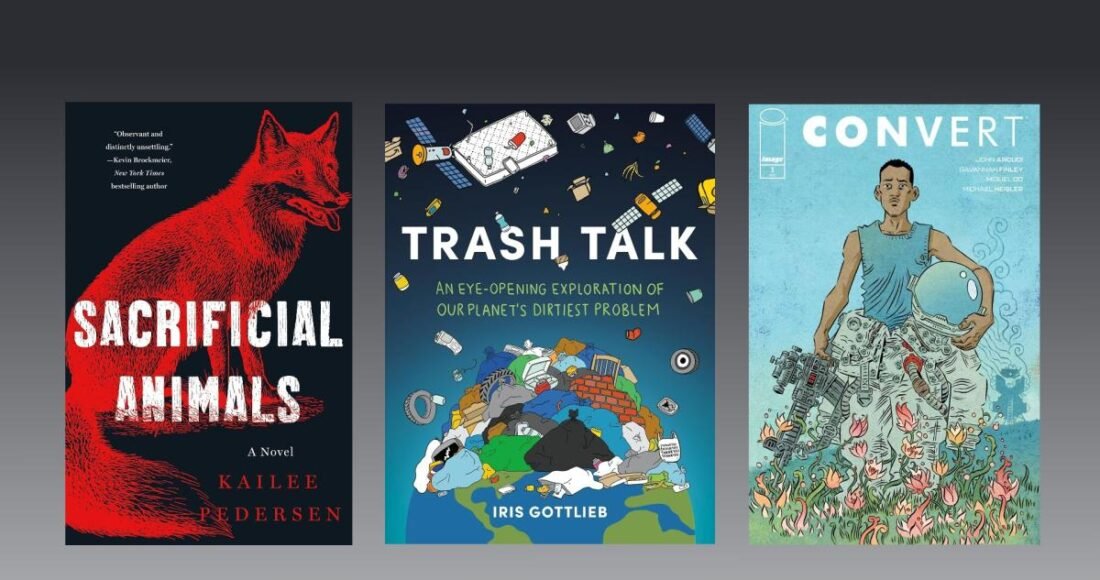New releases in fiction, nonfiction and comics that caught our attention.
Sacrificial Animals by Kailee Pedersen
There’s something about the idea of coming home and reawakening dormant familial trauma that just makes for great horror stories, and Sacrificial Animals is no exception. In the novel, brothers Nick and Joshua Morrow return to their family’s farm in Nebraska after many years estranged from their abusive father, reopening old wounds and allowing supernatural forces to take root. Sacrificial Animals bounces between “Then” and “Now” perspectives, painting a picture of the boys’ childhoods under the violent and racist man, and the gravity of returning once they learn he is dying.
The slow burn horror story weaves in Chinese mythology, using flowery language and a Cormac McCarthy-like lack of quotation marks (and McCarthy-like brutality) to really give it a folkloric feel. But do yourself a favor and skip the blurb if you plan on reading this one, as it betrays a bit too much about the direction the story will go.
Trash Talk: An Eye-Opening Exploration of Our Planet’s Dirtiest Problem by Iris Gottlieb
Humanity’s trash problem is one so massive and complex it can be difficult to even comprehend, especially for those of us who are more or less removed from the reality of it. I mean, it feels like every other week I learn that an item I’ve long been told is recyclable is, in fact, not recyclable, and garbage is even piling up in space. Iris Gottlieb’s Trash Talk: An Eye-Opening Exploration of Our Planet’s Dirtiest Problem breaks the whole issue down, diving into the many facets of global trash production and management, and exploring how we got to where we are.
It’s filled with illustrations and insight to help contextualize a problem that, unfortunately, isn’t going away any time soon, and is a great read for anyone who wants to know more about what really happens to your garbage when you throw it “away.”
Convert by John Arcudi, Savannah Finley
The first thing that popped into my mind when I saw the cover for issue #1 of Convert was Jeff VanderMeer’s Southern Reach Trilogy. A man in a space suit — with the helmet removed — stands in a field holding a huge gun, surrounded by strange flora that almost seems like it’s trying to consume him. The mental comparisons to the Area X of VanderMeer’s series only continued as I read through it, but a development its final few panels affirms that Convert has its own unique story to tell.
The first issue of the new science fiction/fantasy series from Image Comics was released this week, and visually, it’s stunning. In the opening pages, “Science Officer Orrin Kutela finds himself stranded on a distant planet, starving and haunted by the ghosts of his dead crew,” per the description. “On the verge of death, he makes an astonishing discovery.” Convert was written by John Arcudi, with art by Savannah Finley, colors by Miguel Co and lettering by Michael Heisler. The second issue drops September 25.
This article contains affiliate links; if you click such a link and make a purchase, we may earn a commission.






Can you be more specific about the content of your article? After reading it, I still have some doubts. Hope you can help me.
amoxil without prescription – comba moxi purchase amoxil generic
buy generic amoxicillin over the counter – combamoxi.com order amoxil pill
fluconazole 200mg generic – https://gpdifluca.com/# diflucan 200mg cost
purchase diflucan pill – site fluconazole 100mg oral
order lexapro online – https://escitapro.com/ escitalopram pills
where to buy escitalopram without a prescription – https://escitapro.com/ escitalopram 10mg cheap
order generic cenforce 100mg – purchase cenforce without prescription order cenforce pills
buy cenforce without prescription – fast cenforce rs cenforce 50mg us
online cialis – https://ciltadgn.com/ best place to buy generic cialis online
ordering tadalafil online – fast ciltad great white peptides tadalafil
overnight cialis – this cialis super active vs regular cialis
which is better cialis or levitra – https://strongtadafl.com/# cialis with dapoxetine 60mg
sildenafil citrate tablets 100mg – https://strongvpls.com/# hard sale evolution viagra salesman
viagra pill 100mg – on this site order cheap viagra online uk
Thanks for sharing. It’s acme quality. https://buyfastonl.com/amoxicillin.html
I couldn’t hold back commenting. Well written! https://buyfastonl.com/amoxicillin.html
I couldn’t resist commenting. Well written! https://gnolvade.com/
The sagacity in this piece is exceptional. este sitio
Thanks for putting this up. It’s well done. https://ursxdol.com/doxycycline-antibiotic/
I couldn’t resist commenting. Warmly written! https://prohnrg.com/product/loratadine-10-mg-tablets/
Thanks on putting this up. It’s well done. https://prohnrg.com/product/priligy-dapoxetine-pills/
The thoroughness in this piece is noteworthy. https://ursxdol.com/augmentin-amoxiclav-pill/
More delight pieces like this would make the интернет better. lasix 40 mg pour chien
This is the stripe of serenity I get high on reading. faut il une ordonnance pour du viagra
Your article helped me a lot, is there any more related content? Thanks!
More text pieces like this would make the web better. https://ondactone.com/simvastatin/
More posts like this would make the blogosphere more useful. https://ondactone.com/product/domperidone/
This website exceedingly has all of the tidings and facts I needed about this participant and didn’t positive who to ask.
avodart generic
The depth in this piece is exceptional.
https://doxycyclinege.com/pro/ondansetron/
More posts like this would make the online elbow-room more useful. http://www.fujiapuerbbs.com/home.php?mod=space&uid=3616668
I’ll certainly bring back to review more. http://seafishzone.com/home.php?mod=space&uid=2293999
generic forxiga 10 mg – click where to buy dapagliflozin without a prescription
dapagliflozin over the counter – order forxiga 10mg online where to buy forxiga without a prescription
order xenical for sale – janozin.com purchase orlistat for sale
order xenical generic – xenical sale buy xenical 120mg pills
Thanks an eye to sharing. It’s top quality. http://bbs.51pinzhi.cn/home.php?mod=space&uid=7113259